
Subtitles & vocabulary
Rachel's English Trifle ✏️Learn English with Friends TV Show ?Rachel’s English
00
Summer posted on 2020/10/08Save
Video vocabulary
episode
US /ˈɛpɪˌsod/
・
UK /'epɪsəʊd/
- Noun
- One separate event in a series of events
- Show which is part of a larger story
B1TOEIC
More pronunciation
US /prəˌnʌnsiˈeʃən/
・
UK /prəˌnʌnsiˈeɪʃn/
- Noun (Countable/Uncountable)
- How a word is said; how a word sounds
- The manner in which someone utters a word.
B1
More phrase
US /frez/
・
UK /freɪz/
- Noun
- Common expression or saying
- Section of musical notes in a piece of music
- Verb (Transitive/Intransitive)
- To choose words to say what you mean clearly
A2
More tricky
US /ˈtrɪki/
・
UK /'trɪkɪ/
- Adjective
- Difficult, so needing skill to do or deal with
- Likely to use tricks; dishonest or deceptive
A2
More Use Energy
Unlock All Vocabulary
Unlock pronunciation, explanations, and filters
